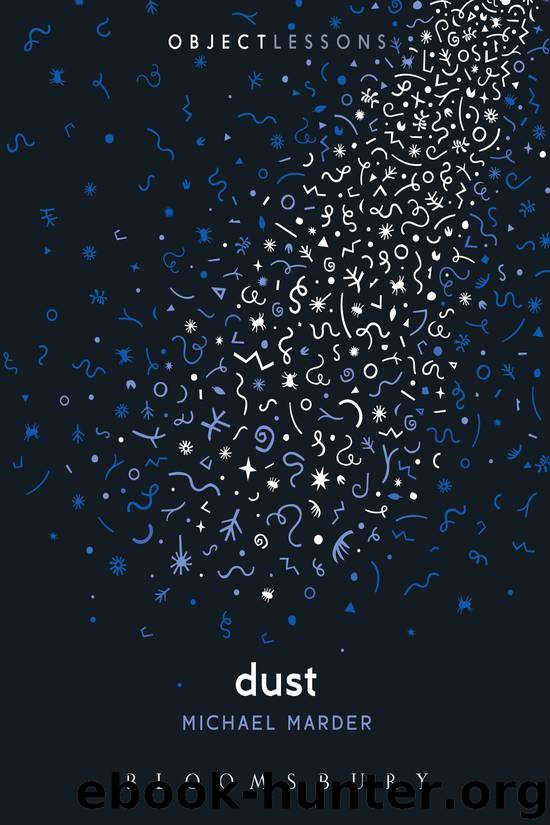Dust by Michael Marder

Author:Michael Marder
Language: eng
Format: epub
Publisher: Bloomsbury USA
eating our dust . . .
Not by accident, two of the most thought-provoking and relatively recent books on dust—Joseph Amato’s 2000 Dust: A History of the Small & the Invisible and Carolyn Steedman’s 2001 Dust: The Archive and Cultural History—contemplate a variety of ways, in which this stuff can make us sick. Dust is the generally invisible wellspring of infections, industrial air pollution, and the all-too-literal archive fever that can lead a scholar, exposed to the crumbling leather of book bindings, to develop migraine headaches or to break out in hives. The Great Cleanup, initiated in the nineteenth century, did nothing to stop the onslaught of dust. “As dust and dirt are banished,” Amato admits, “waste and garbage multiply.”7
By now, we are well acquainted with the bewildering logic of dust, according to which “less” means “more.” Having said that, a physical or physiological sickness associated with it is a symptom of still another malady. One of the reasons why dust allergies afflict us in our houses is that we have no idea of what it means to dwell; we are out of practice as far as dwelling is concerned. Take mobility, for instance. An increase in traffic on our streets and highways leads to an upsurge of road dust, raised by the speeding vehicles. Paved road dust is not an abstract atmospheric pollutant, but one that substantially augments the incidence of allergies. In 1999, researchers from California found that, in addition to the toxic stew of exhaust, tire, and break lining wear particles, this kind of dust contained allergens from twenty other sources, including pollen, animal dander, and mold.8 Lifted by the passing traffic, this mix hovers over the road and heightens the concentration of allergens in the vicinity. “Dust allergies” are not circumscribed to domestic problems alone. They make the difference between the inside and the outside of the dwelling hazy and they are aggravated by our collective propensity to raise dust on the highway or at the factory, on a construction site or at a farm.
Kicking inordinate quantities of road dust into the air, our mobility is part and parcel of the restlessness factored into the modern condition. The aspirations of progress set off an unforgiving race to outdo other individuals, countries, generations. The motto of a modern individual boils down to the crude idiomatic expression, “Eat my dust!” But, since dust does not respect oppositional pairings, our victory in this mad race is equivalent to defeat. After we surpassed a critical mass of dust generated by industrial-scale activities, we have outpaced ourselves and exceeded the limits of what our bodies can tolerate. Today, we eat our own dust. The spike in allergies, asthmas, and other chronic conditions is, at once, a medal in this race without a clear finish line and a sign of our defeat.
If dwelling means remaining, staying in place, or abiding, then it sharply contrasts with restlessness, which instigates our wanderings from place to place and underpins our dissatisfaction with any given locale. When
Download
This site does not store any files on its server. We only index and link to content provided by other sites. Please contact the content providers to delete copyright contents if any and email us, we'll remove relevant links or contents immediately.
Cecilia; Or, Memoirs of an Heiress — Volume 1 by Fanny Burney(31368)
Cecilia; Or, Memoirs of an Heiress — Volume 3 by Fanny Burney(30965)
Cecilia; Or, Memoirs of an Heiress — Volume 2 by Fanny Burney(30921)
The Great Music City by Andrea Baker(22197)
We're Going to Need More Wine by Gabrielle Union(18105)
Bombshells: Glamour Girls of a Lifetime by Sullivan Steve(13135)
Pimp by Iceberg Slim(12968)
All the Missing Girls by Megan Miranda(12805)
Fifty Shades Freed by E L James(12475)
Talking to Strangers by Malcolm Gladwell(11940)
Norse Mythology by Gaiman Neil(11935)
Crazy Rich Asians by Kevin Kwan(8388)
Mindhunter: Inside the FBI's Elite Serial Crime Unit by John E. Douglas & Mark Olshaker(7871)
The Lost Art of Listening by Michael P. Nichols(6504)
Enlightenment Now: The Case for Reason, Science, Humanism, and Progress by Steven Pinker(6430)
Bad Blood by John Carreyrou(5799)
The Four Agreements by Don Miguel Ruiz(5547)
Weapons of Math Destruction by Cathy O'Neil(5070)
We Need to Talk by Celeste Headlee(4900)
